Learn how to make pie crust with this easy pie dough recipe! It yields a flaky, buttery crust that's perfect for using in your favorite homemade pies.

If the prospect of making homemade pie dough intimidates you, you have to try this easy pie crust recipe. As a lover of basically every kind of pie, I’ve experimented with a variety of techniques for making pie dough over the years. I’ve had my fair share of successes, near successes, and all-out failures. But since I’ve started making this pie crust recipe, it’s worked like a charm every time. Made in a food processor using a technique that J. Kenji López-Alt pioneered for Cook’s Illustrated in 2007, it’s far more pliable than a traditional pie dough, which makes it much easier to roll out. It’s also made with 100% butter, which gives it an AMAZING flavor and wonderful flaky texture. What more could you want in a homemade pie crust?

Pie Crust Recipe Ingredients
Here’s what you’ll need to make this easy pie crust recipe:
- All-purpose flour – I use 2 2/3 cups to make two crusts, enough for one 9- or 9.5-inch double crust pie or two single crust pies. Spoon and level your flour to avoid packing too much into your measuring cup!
- Cold butter – Pie crust recipes often call for a mix of butter and shortening (or even lard), but I prefer to make an all-butter pie crust. The flavor is far richer, and the crust has a lovely flaky texture.
- Ice water – It helps the dough come together, and it aids essential gluten development in some of the flour.
- Apple cider vinegar – It makes the dough a little more flavorful, and if you happen to overwork the dough, the vinegar will prevent it from getting too tough.
- And sea salt – To bring out the crust’s rich, buttery flavor.
Find the complete recipe with measurements below.
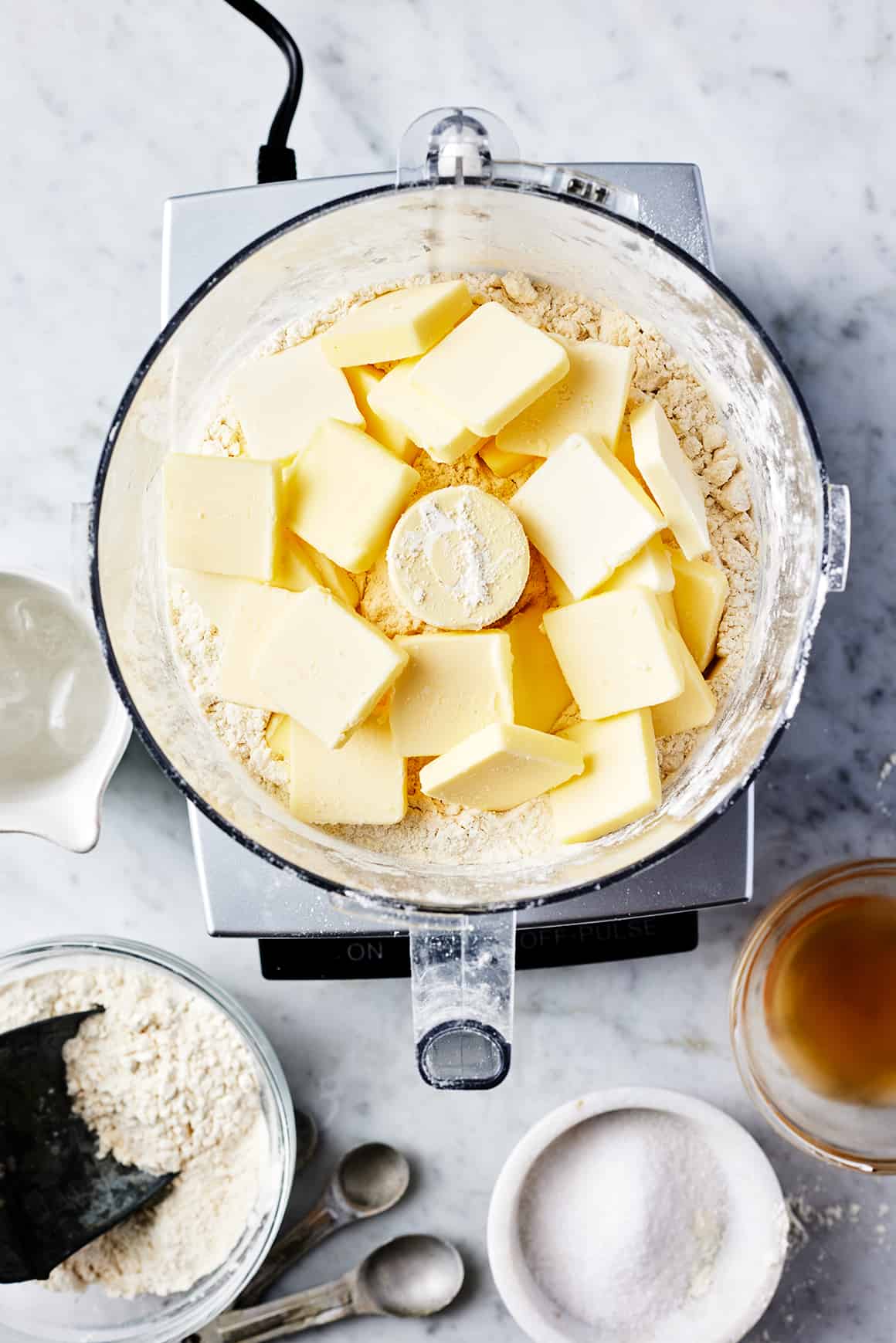
How to Make Pie Dough
In a traditional pie dough recipe, you’d cut the fat into the flour by hand or with a pastry cutter and then gradually add water until the dough comes together. Though you can make great pie crusts with this method, it’s less foolproof than the one we use here. It’s easy to add too much or too little water or to overwork the dough so that it becomes tough.
In this method, which J. Kenji López-Alt developed at Cook’s Illustrated, you’ll use a food processor to thoroughly combine the butter with some of the flour. Then, you’ll pulse in the rest of the flour until the dough becomes crumbly. At that point, you’ll transfer the dough to a bowl and add the liquid. The big benefits of this method are that, because the butter is thoroughly mixed with part of the flour, the dough is pliable and easy to roll out. It also stays tender, as the gluten develops in only the second addition of flour.
Here’s how it goes:
First, pulse the butter into part of the flour. Place 1 2/3 cups of the flour and the salt in a food processor and pulse to combine. Spread the butter on top.

Pulse until the butter is thoroughly incorporated with the flour and the dough starts to form clumps.
The mixture pictured above is almost at that point, but not quite. It needs a few more pulses in the food processor. Before you move on to the next step, there should be no dry flour remaining.
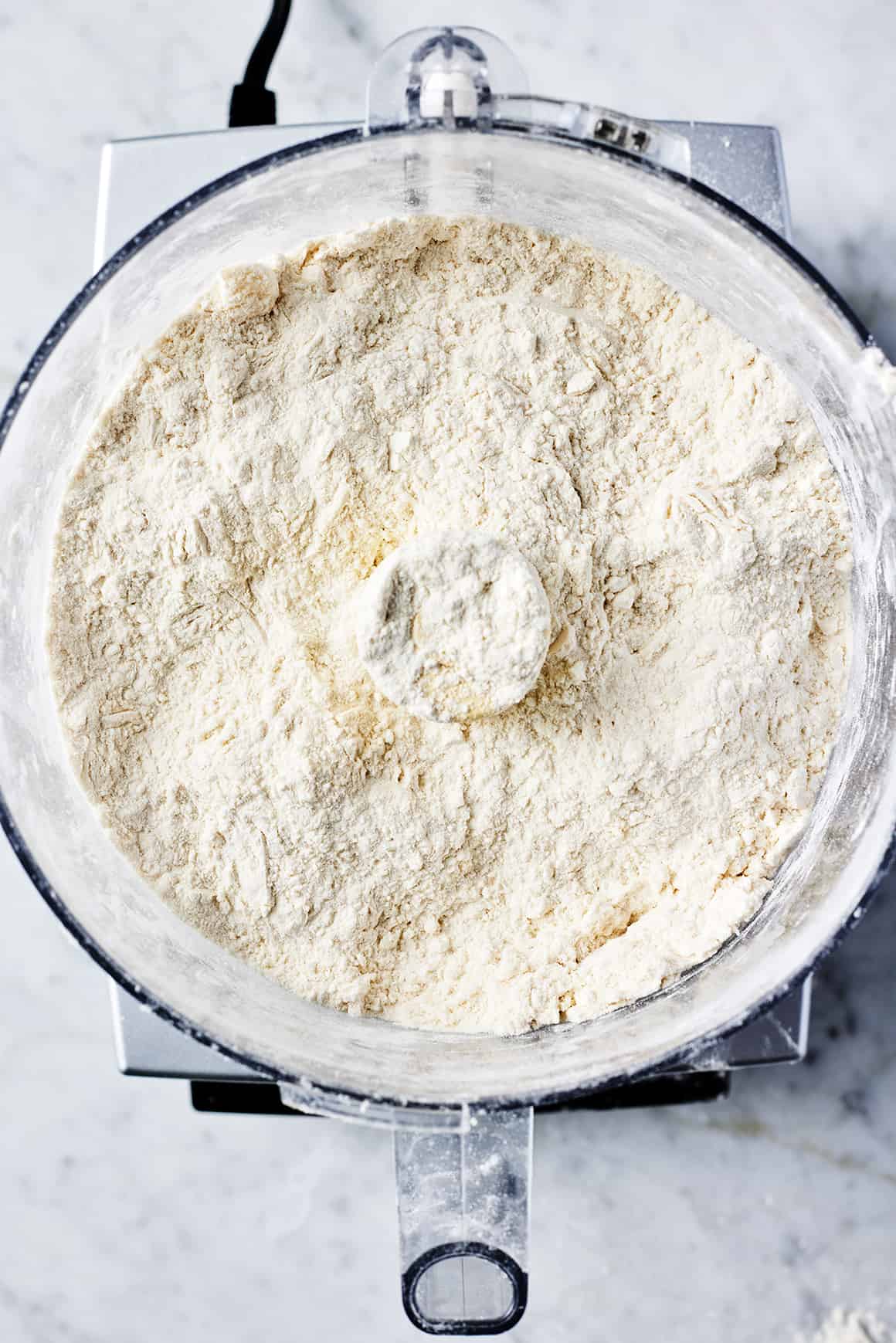
Then, add the remaining flour. Spread the flour/butter mixture evenly in the food processor and sprinkle the remaining flour on top.

Briefly pulse until the dough becomes crumbly.
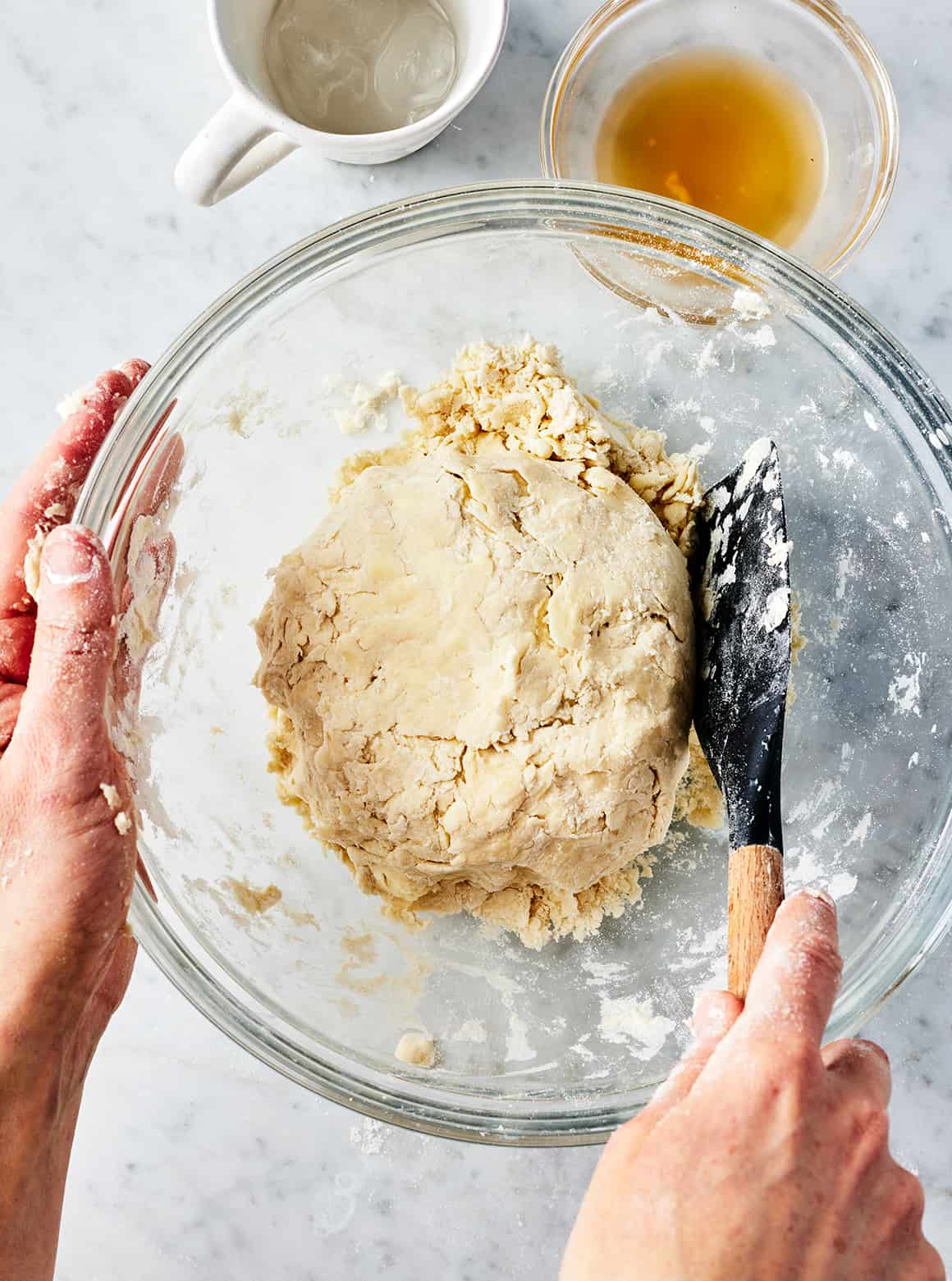
Next, add the liquid. Transfer the dough to a large bowl and sprinkle in the water and vinegar. Use a spatula to fold and press the dough until it comes together into a ball.
Finally, chill the dough. Divide it in half and flatten each half into a disk. Wrap tightly in plastic wrap and refrigerate for at least 2 hours or up to 2 days.
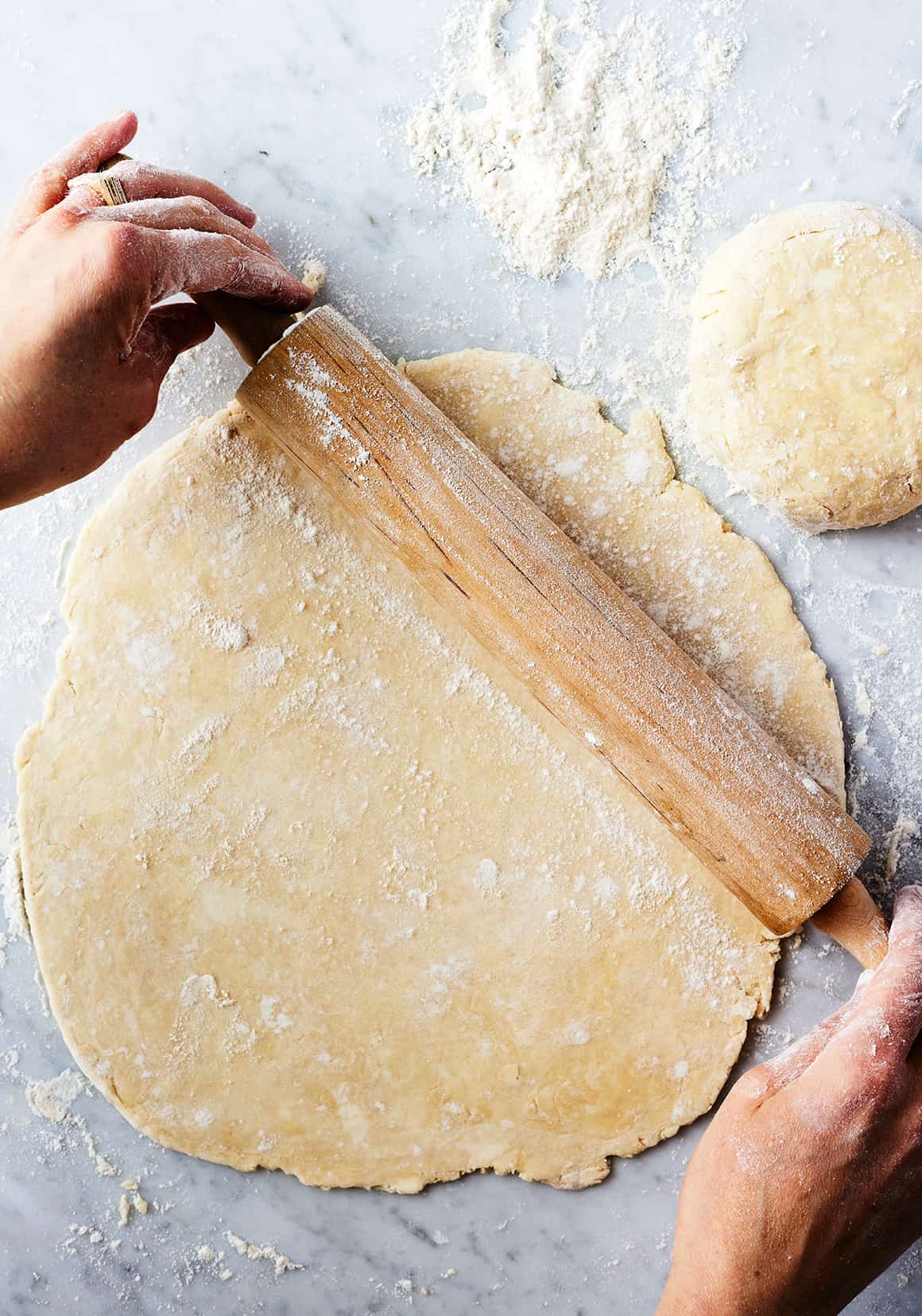
Rolling Out The Dough
Once the dough has chilled, you can roll it out and assemble your pie!
Place one of the disks of dough on a lightly floured surface. Dust the top of the dough with flour, and roll it out into a large circle about 1/8-inch thick.
As you work, rotate the dough a quarter turn every few rolls. Unless you’re rolling out the dough on parchment paper, rotating it as you roll is essential. It helps you create a more even circle, but, more importantly, it prevents the dough from sticking irretrievably to your work surface. I also like to dust the top of the dough with flour and flip it over a few times as I roll it out.
Roll out the dough until it’s about 1/8-inch thick. If you invert your pie pan over the dough, the dough should be 1 inch larger than the pan on all sides.
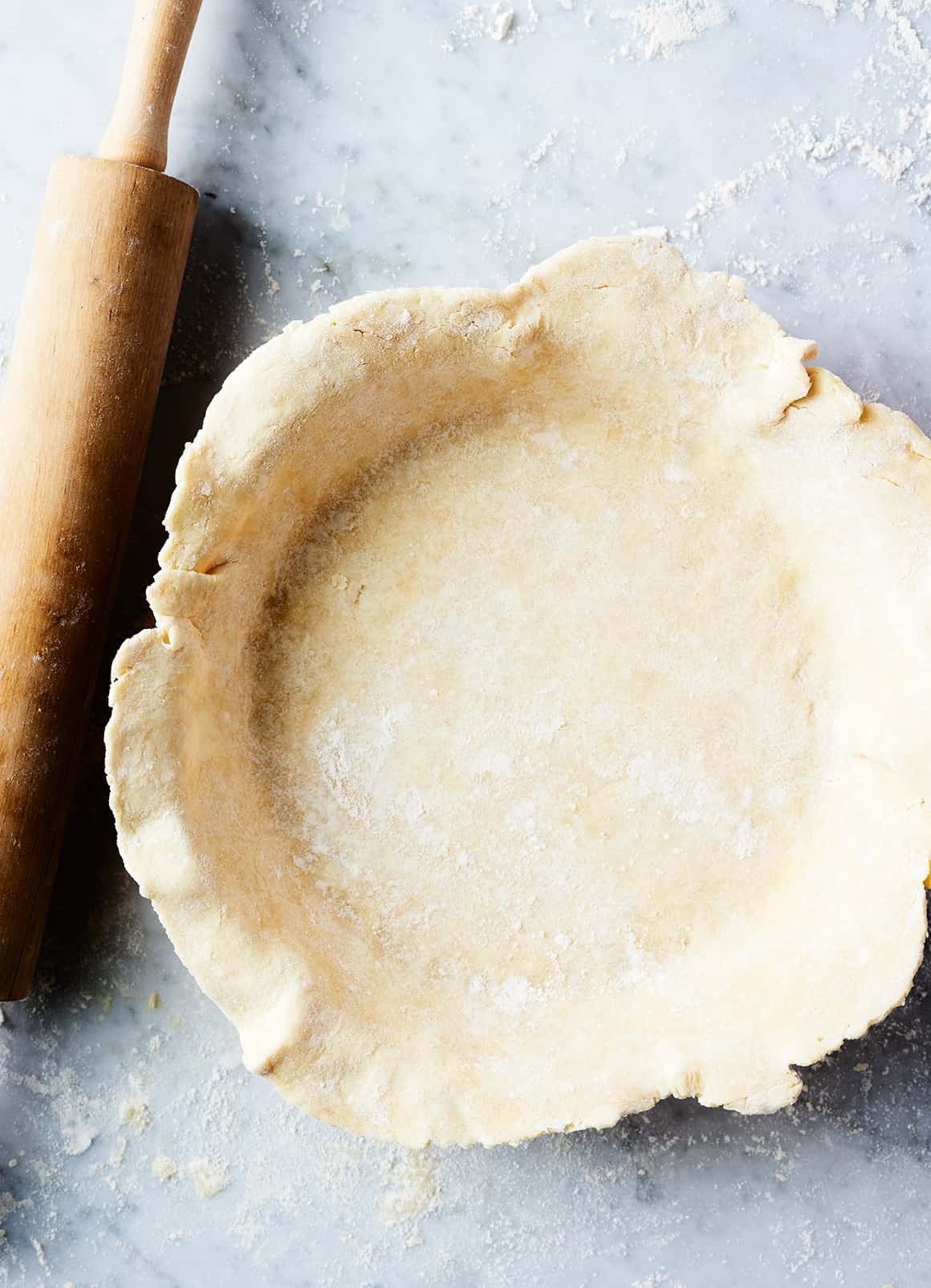
Finally, transfer the dough to your pie plate. Gently roll it over your rolling pin. Then, unroll it over the pie dish and press it firmly into the bottom and up the sides.
If you’re making a single crust pie, use a sharp knife or kitchen scissors to trim any excess dough, leaving a 1/2-inch overhang on all sides of the pie plate. Roll the dough under itself so that the edges are in line with the edges of the pie plate. Crimp with your fingers or a fork, and follow your pie recipe to bake. (Use the remaining dough to make a second pie, or store it in the freezer it for up to 3 months!)
If you’re making a double crust pie, roll out the second disk of pie dough to make the top crust. Assemble and bake according to your desired pie recipe!
Blind Baking Pie Crust
Blind baking simply refers to pre-baking pie crust, and it’s a handy technique for avoiding a dreaded soggy bottom crust. It’s not necessary in all pie recipes (I don’t blind bake my crust for this cherry pie, for example), but you’ll often see it used in recipes for custardy pies like pumpkin, whose crusts are especially prone to sogginess. Here’s how to blind bake this homemade pie crust recipe:
- Roll out the bottom crust, transfer it to your pie plate, and crimp the edges as desired. Loosely tent with plastic wrap and refrigerate while you preheat the oven to 425°F. Chilling the dough at this stage will help it hold its shape in the oven.
- Fill it with pie weights. When the oven is hot, remove the plastic from the crust and prick the bottom all over with a fork. Line the crust with parchment paper or aluminum foil, and add enough dried beans or pie weights to reach the top of the pie plate. Without the weights, the crust will shrink away from the sides of the pan as it bakes, so make sure to fill the pan all the way.
- Bake the crust with the pie weights. Transfer the pie plate to the oven and bake for 15 minutes, until the edges of the pie crust are set.
- Bake the crust without the pie weights. Take the crust out of the oven and carefully remove the beans or pie weights and parchment or aluminum. Return the crust to the oven and bake for another 5 to 8 minutes, or until the bottom of the crust is beginning to set and turn light golden brown.
- Let it cool to room temperature before adding your desired filling and baking your pie. That’s it!

Easy Pie Crust Recipe Tips
- Keep everything cold. Making pie crust with butter has huge benefits, especially in terms of flavor. But the downside of working with butter is that it melts easily. In order to make a light and flaky crust, you want the butter to melt in the oven, not while you’re making the dough or assembling the pie. My best tip for ensuring this happens is just keeping your ingredients cold. I like to take butter straight from the fridge, cut it into pats, and stick it back in the fridge while I gather the rest of the ingredients. I also use cold vinegar and ice water in the dough. In addition, it’s important that you don’t cut the chilling time short. Make sure to refrigerate the pie dough for at least 2 hours before you roll it out!
- Fold in the water using a spatula. I find that when I add it in the food processor it gets stuck under the blade, so it doesn’t evenly hydrate the dough. Folding the dough with the spatula helps create nice layers, too.
- Don’t let it scare you. With this easy pie crust recipe, you’ll be able to make great homemade pie crust on your first try. It removes a lot of the guesswork that you’d find in a traditional pie crust recipe, and it yields a dough that’s pliable and easy to work with. Don’t be afraid to try it! I hope you love the results, and like anything else, the more you practice making perfect pie crust, the easier it gets.

Looking for pie recipes? Use this homemade pie dough to make my Sour Cherry Pie or this Crumble Apple Pie.

Easy Pie Crust
Ingredients
- 2⅔ cups all-purpose flour, spooned and leveled
- ¾ teaspoon sea salt
- 20 tablespoons cold unsalted butter, 2½ sticks, cut into ¼-inch pats
- 6 tablespoons ice water
- 1 teaspoon cold apple cider vinegar
Instructions
- In a food processor, place 1⅔ cups of the flour and the salt. Pulse to combine. Spread the butter pats evenly on top of the flour mixture. Pulse until the butter is well combined with the flour and the dough starts to form clumps. There should be no dry flour remaining.
- Spread the mixture evenly in the bowl of the food processor and sprinkle the remaining 1 cup flour on top. Briefly pulse until the dough becomes crumbly.
- Transfer the dough to a large bowl and sprinkle the water and vinegar on top. Use a spatula to fold and press the dough until it comes together into a ball. Divide the ball in half and form each half into a 1-inch-thick disk. Wrap each disk tightly in plastic wrap and chill for at least 2 hours or up to 2 days.
- To roll out the dough: Place 1 disk of the chilled dough on a lightly floured surface. Dust the top with flour and use a rolling pin to roll it out into a large circle about ⅛-inch thick. If you invert your pie plate over the dough, the circle should be 1 inch larger than the edge of the pie plate on all sides. As you work, rotate the dough a quarter turn every few rolls to prevent it from sticking to your work surface. I also like to dust the top of the dough with flour and flip it over a few times during the rolling process.
- To transfer the rolled-out dough to your pie plate, roll the dough over the rolling pin and unroll it over the pie plate. Use your fingers to press it firmly into the bottom and up the sides of the plate. Trim the edges of the dough so that there is a ½-inch overhang on all sides of the pie plate. Loosely cover the dough with plastic wrap and chill while you roll out the top crust.
- Repeat the rolling process with the remaining dough disk, rolling it out into a large, ⅛-inch-thick circle.
- Assemble and bake according to your desired pie recipe.










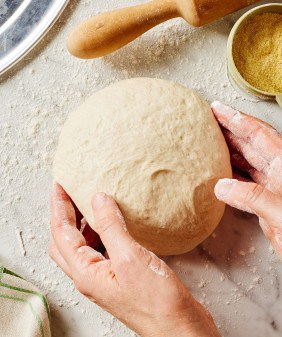



Hi Joe, It’s possible that scaling up the recipe may have caused some of the issues. Sometimes baking recipes can come out differently when they’re scaled up, and the larger batch would have been harder to work with in the food processor. I’m sorry that you were disappointed with the results!
Do you upload recipes in grams ever or would you post grams for this?
MY SEARCH IS OVER!! I have struggled for years to find a crust recipe that is easy to make, easy to roll, and bakes up tender and flaky, but I will look no more! Thank you for posting this, and know that you’ve made a huge difference for at least one person 🙂
Hi Pati, we’re so happy to hear that!
To be honest I did not care for this pie crust. Too difficult to make, uses way too much butter, and the result isn’t better than other easier and less expensive pie crusts I have made. I personally am fine with more “doughy” crusts though, I don’t need my crust to be like croissant dough, so it’s probably a personal preference thing.
Probably the easiest pie dough I’ve ever made is the “sour cream crust”, but it requires sour cream be on hand which is often a limiting factor.
Excellent crust. Easy to make, easy to work with, and delicious. This is now my go-to recipe.
Hi Lou, I’m so glad it was easy to make!
I’ve struggled over the years trying to find a pie crust recipe that was full proof and easy to work with. And the moment I tried your recipe, I was like where have you been. I’m telling I had given up. I started using frozen pre-made. Thank you for sharing. Which of your cook books can I find this recipe?
Hi Angela, so great to hear! I’m glad you loved the pie crust. At the moment, this recipe is just on the blog. We generally publish separate recipes online and in our cookbooks.
I continued the recipe entirely in the food processor. Pulsing as the cold water trickled down. As soon as it formed into a ball, I removed and divided the dough. It came out perfectly.
Hi Dana, amazing! So glad you had success making this in the food processor.
I’ve been making pies for several years with a good success rate. I have used different recipes and thought I’d try this new technique. It was easy enough with the food processor, but it never really came together in the bowl when adding the cold water and cider. with a spatula. I made the discs as well as I could and chilled them overnight, but alas, the next morning the dough was still loose and flourey. It only came together when I added more ice water. Will I try it again? Probably! With fingers crossed.
Hi Mia
I’m in Australia too so I googled it:
BUTTER STICKS CUPS TABLESPOONS OUNCES GRAMS
½ stick ¼ cup 4 Tbsp. 2 oz. 57 g
1 stick ½ cup 8 Tbsp. 4 oz. 113 g
1½ sticks ¾ cup 12 Tbsp. 6 oz. 170 g
2 sticks 1 16 Tbsp. 8 oz. (½ pound) 227 g
Good Luck. Glenys
How much is 20 tbspns butter in grams or ounces?
Vegan butter caution: Just made the dough according to the instructions but with plant based butter but have to make again with real butter. . Measured everything carefully but even with the second cup of flour there was no crumbliness and water and vinegar pretty much just sloshed around. Will try baking the result as a test in a couple of hours but am not optimistic. I’m sure it will be delicious made with dairy butter.
No. It’s a food processor recipe. There are lots of recipes for making pie dough by hand but this is not one of them.
I couldn’t find any instructions for making it without the food processor. Did I miss something?
Jeanine, could King Arthur’s gluten-free all-purpose flour successfully be used to make this crust? My niece isn’t able to consume any gluten.
I made this last night and it’s chilling in the fridge. Looks and feels like it’s super tough/stiff, is it normal?
Hi Vera, Did you change anything about the recipe?
Jeanine, my niece isn’t able to consume any gluten. Could King Arthur’s glute-free all-purpose flour successfully be used to make this crust?
Hi Carolyn, We haven’t tried using a gluten-free blend for this crust, so we can’t say for sure. I’d recommend looking for a pie crust recipe that specifically calls for gluten-free flour. If you’re open to a nontraditional crust, we love the pecan crust from this pumpkin pie recipe!
I like the idea of blind baking for my pumpkin pie, but won’t my edges risk getting overdone with the time required to bake the pie filling? I know I can use a pie rim to cover the edges but I’m not sure that will be enough to prevent over- browning.
Hi Traci, I blind baked this crust for a pumpkin pie last weekend, and it worked nicely! Because most pumpkin pies bake at a relatively low temperature, 350F or so, the crust shouldn’t brown too much. I would recommend baking the pumpkin pie with a pie rim or foil over the edges if you really want to manage browning – it will help! Have a great Thanksgiving.
Could you use vegan butter with this crust without changing the integrity of it?
Hi Ashley, We are planning to try this, but we haven’t yet, so I can’t guarantee the results. If you try it, let us know how it goes!
For this pie crust, would you recommend freezing it in the disc-form to have on hand?
Made a cherry pie using this pie crust recipe. My family loved it. They said it was the best pie crust they ever had. Thanks for sharing the recipe.
I’m so happy to hear!
This pie crust is fabulous! Haha, I made a cherry pie and my husband said, “ The best part of this pie is the crust.” It takes extra time due to the chilling, but is actually easy and so good. I made the dough one day and refrigerated the dough disks, then the next day made the filling, rolled out the crust and assembled. I hate store-bought crusts — they basically ruin what would have been a delicious pie. This is so easy and predictable using a food processor, I will never use a store-bought crust again.
Hi Evelyn, I’m so glad your pie crust came out so well!
Have you made gluten free pie crust ?
I’m sorry, we haven’t.